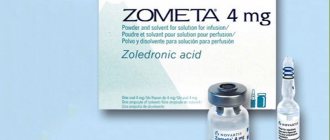Pharmacological properties of the drug Vancomycin
Tricyclic glycopeptide antibiotic obtained from Amycolatopsis orientalis . Vancomycin inhibits the biosynthesis of cell membranes of microorganisms, changes their permeability and disrupts RNA synthesis. There is no cross-resistance between vancomycin and other antibiotics. Staphylococci are sensitive to vancomycin, including Staphylococcus aureus and Staphylococcus epidermidis (including methicillin-resistant strains), streptococci, including Streptococcus pyogenes, Streptococcus pneumoniae (including penicillin-resistant strains), Streptococcus agalactiae, viridans group, Streptococcus bovis and enterococci, Clostridium diffic ile , diphtheroids , Listeria monocytogenes, Lactobacillus spp., Actinomyces spp., Clostridium spp. and Bacillus spp . Gram-negative bacilli, mycobacteria and fungi are insensitive to vancomycin in vitro When combined with aminoglycoside antibiotics, vancomycin exhibits a synergistic effect against many strains of S. aureus , non-enterococcal group D streptococci, enterococci, and Streptococcus spp . ( viridans ). Vancomycin is poorly absorbed after oral administration; to treat systemic infections it is administered intravenously. IM injections are painful. In patients with normal renal function after intravenous infusion of 1 g of vancomycin for 60 minutes, its concentration in the blood plasma immediately after administration is 63 mg/l, after 2 hours - about 23 mg/l, 10 hours after the end of the infusion - 8 mg/l. With repeated infusion administration of 500 mg of the drug over 30 minutes, the concentration in the blood plasma immediately after administration is 49 mg/l, after 2 hours - 19 mg/l, after 6 hours - 10 mg/l. The average half-life of vancomycin from blood plasma for patients with normal renal function is 4-6 hours. 75% of the administered dose of vancomycin is excreted in the urine by glomerular filtration in the first 24 hours. The average plasma clearance is about 0.058 l/kg/h, and the average renal clearance is about 0.048 l/kg/h. Impaired renal function slows down the elimination of vancomycin. In patients with anuria, the average half-life is 7.5 days. Distribution coefficient - 0.3–0.43 l/kg. About 60% of a dose of vancomycin administered intraperitoneally during peritoneal dialysis undergoes systemic adsorption after 6 hours. Serum concentrations of about 10 mg/l are achieved with an intraperitoneal injection of 30 mg/kg body weight of vancomycin. Vancomycin is not effectively removed by hemodialysis and peritoneal dialysis; it is possible to increase the clearance of vancomycin during hemoperfusion. The total systemic and renal clearance of vancomycin may be reduced in the elderly. About 55% of vancomycin is bound to plasma proteins. After IV administration of vancomycin, it is detected in inhibitory concentrations in pleural, pericardial, peritoneal, ascitic and synovial fluids, in urine and atrial appendage tissue. Vancomycin does not readily diffuse through intact meninges into the CSF, but its concentration in the CSF increases during meningitis.
Instructions for use VANCOMYCIN-TF
Vancomycin-TF cannot be administered intramuscularly or intravenously as a bolus! Vancomycin-TF is used only by infusion. The following daily doses are recommended.
For adults
the dose is 500 mg IV every 6 hours or 1 g every 12 hours. The drug is administered as a slow infusion at a rate of no more than 10 mg/min over 60 minutes or more. The concentration of the prepared Vancomycin-TF solution should not exceed 5 mg/ml. The maximum daily dose is 2 g.
For newborns up to 7 days of life
the initial dose is 15 mg/kg, then 10 mg/kg every 12 hours.
Children under 1 month
should be administered 10 mg/kg body weight every 8 hours. For
children 1 month and older,
the recommended dose is 40 mg/kg body weight body/day, divided into individual administrations every 6 hours. It is not recommended to exceed the concentration of the prepared Vancomycin-TF solution more than 2.5-5 mg/ml. The infusion is given over 60 minutes or more. The maximum single dose for a child is 15 mg/kg body weight, the maximum daily dose is 60 mg/kg body weight.
For patients with renal failure
it is necessary to individually select the dose.
The initial dose should be 15 mg/kg body weight, then the interval between dosages is determined in accordance with creatinine clearance.
| Creatinine clearance | Dose of Vancomycin-TF | Interval between infusions |
| >80 ml/min | 500 mg or 1 g | 12 h |
| 80-50 ml/min | 1 g | 24 hours |
| 50-10 ml/min | 1 g | 3-7 days |
| <10 ml/min (anuria) | 1 g | 7-14 days |
In elderly patients
and in
premature infants
, due to deterioration of renal function, a dose reduction or an increase in the interval between doses may be required.
For the treatment of staphylococcal enterocolitis and pseudomembranous colitis caused by Clostridium difficile, Vancomycin-TF is prescribed orally. Usual Daily Oral Dose for Adults
ranges from 500 mg to 1 g, for
children
- 40 mg/kg body weight, divided into 3-4 doses; course of treatment is 7-10 days. It is not recommended to exceed the daily dose of more than 2 g.
Rules for preparing and administering the solution
Preparation of solution for intravenous administration
. The solution is prepared immediately before administration of the drug. To prepare a solution of Vancomycin-TF with a concentration of 50 mg/ml, add the required volume of solvent to the bottle (10 ml to a bottle containing 500 mg of Vancomycin-TF and 20 ml to a bottle containing 1 g). The resulting solution must be further diluted in 100 ml or 200 ml of solvent to a concentration of no more than 5 mg/ml. As solvents, you can use water for injection, 0.9% sodium chloride solution for injection or 5% glucose solution for injection.
Preparation of a solution for oral administration.
The recommended dose of Vancomycin-TF is dissolved in 30 ml of water. The prepared solution can be prescribed for drinking or administered to the patient through a tube. Food syrups can be used to improve the taste of the solution.
Indications for use of the drug Vancomycin
Severe infections caused by sensitive strains of methicillin-resistant staphylococci, with intolerance to penicillins, cephalosporins, as well as infections caused by microorganisms sensitive to vancomycin, resistant to other antimicrobial drugs or allergic to penicillin. Vancomycin is effective for staphylococcal endocarditis, sepsis, osteomyelitis, diseases of the lower respiratory tract, skin and soft tissues, as well as for antibacterial therapy during the surgical treatment of purulent processes caused by staphylococci. For endocarditis caused by Streptococcus viridans and S. bovis , monotherapy with vancomycin or a combination of the drug with aminoglycoside antibiotics is effective, and for endocarditis caused by enterococci (for example E. faecalis ), vancomycin is effective only in combination with aminoglycoside antibiotics. Vancomycin has been successfully used to treat patients with diphtheroid endocarditis, and in combination with aminoglycosides and/or rifampicin to treat patients with early endocarditis caused by S. epidermidis or diphtheroids after heart valve replacement. Vancomycin in the form of a parenteral solution can be used orally for the treatment (due to the use of antibiotics) of patients with pseudomembranous colitis caused by C. difficile and staphylococcal enterocolitis. For other types of infections, oral vancomycin hydrochloride is not effective. The American Heart Association and the American Dental Association have suggested vancomycin as a prophylactic agent for bacterial endocarditis in patients with penicillin allergy, congenital heart disease, rheumatic or other acquired heart valve disease, or undergoing upper respiratory surgery or dental surgery. .
Vancomycin, 1 piece, 500 mg, powder for solution for infusion
Vancomycin is a tricyclic glycopeptide antibiotic produced by Amycolatopsis orientalis. The bactericidal effect of vancomycin is manifested in the inhibition of bacterial cell wall biosynthesis and is capable of changing the permeability of the bacterial cell membrane and the synthesis of ribonucleic acid (RNA). Blocks the synthesis of the bacterial cell wall at a site different from that on which penicillins and cephalosporins act (without competing with them for binding sites), strongly binding to O-alanyl-O-alanine residues of peptidoglycan subunits (located on the outer surface of the cytoplasmic membrane) - a major component of the cell wall, which leads to cell lysis.
Shows a bactericidal effect against many gram-positive bacteria and a bacteriostatic effect against Enterococcus spp. Bactericidal effect on Enterococcus spp. achieved by the combined administration of vancomycin and aminoglycosides. There is no cross-resistance between vancomycin and other classes of antibiotics.
Active against gram-positive microorganisms: Staphylococcus aureus, Staphylococcus haemolyticus, Staphylococcus epidermidis (including heterogeneous methicillin-resistant strains), Streptococcus spp. (Streptococcus pyogenes, Streptococcus pneumoniae, Streptococcus agalactiae and others, including penicillin-resistant strains), Enterococcus spp. (including Enterococcus faecalis), Clostridium spp., Propionibacterium acnes, Actinomyces spp., some strains of Lactobacillus spp., Rhodococcus spp., Corynebacterium spp., Listeria monocytogenes, Bacillus spp.
In vitro, some isolated strains of Enterococcus spp. and Staphylococcus spp. may exhibit resistance to vancomycin.
In combination with aminoglycosides, in vitro synergism is observed against many strains of Staphylococcus aureus, group D streptococci that do not belong to enterococci, Enterococcus spp., Streptococcus viridans group. In combination with gentamicin, tobramycin, rifampicin, imipenem, a synergistic effect is observed against Staphylococcus aureus. In some cases, with a combination of vancomycin and rifampicin, antagonism of action is observed against strains of Staphylococcus spp., This combination of drugs also exhibits synergistic action against some strains of Streptococcus spp.
Vancomycin is inactive in vitro against gram-negative microorganisms, mycobacteria and fungi.
The optimum action is at pH 8; when the pH decreases to 6, the effect decreases sharply.
The development of resistance in staphylococci during therapy is very rare. The minimum inhibitory concentration (MIC) value for most antibiotic-sensitive microorganisms is less than 5 μg/ml; the MIC value for vancomycin-resistant Staphylococcus aureus strains reaches 10-20 mg/l.
When used orally, it has a minimal systemic effect and acts locally on sensitive microflora in the gastrointestinal tract (GIT) (Staphylococcus aureus, Clostridium difficile).
Use of the drug Vancomycin
Infusion-related adverse events are related to the concentration and rate of vancomycin administration. For adults, it is recommended to prescribe in a concentration not higher than 5 mg/ml, the rate of administration is not more than 10 mg/min. For patients who need to limit fluid intake, vancomycin can be prescribed at concentrations up to 10 mg/ml, but this increases the risk of side effects. For adults with normal renal function, the average daily dose is usually 2 g IV in 2 or 4 administrations (0.5 g every 6 hours or 1 g every 12 hours). Each dose is administered at a rate of no more than 10 mg/min or over a period of at least 60 minutes; choose the slowest mode of administration. For children, the usual dose of vancomycin is 10 mg/kg body weight, administered intravenously every 6 hours. For newborns and young children, the daily dose may be lower. For both newborns and young children, an initial dose of 15 mg/kg is recommended, followed by 10 mg/kg every 12 hours for newborns in the 1st week of life and every 8 hours for children under 1 month of age. . Patients with impaired renal function and the elderly require dose adjustment. The daily dose of vancomycin (mg) is approximately 15 times the glomerular filtration rate (ml/min). Glomerular filtration (ml/min) and the required dose of vancomycin (mg) are respectively 100/1545, 90/1390, 80/1235, 70/1080, 60/925, 50/770, 40/620, 30/465, 20/ 310 and 10/155. The initial dose of vancomycin, even for patients with mild to moderate renal failure, should be at least 15 mg/kg body weight. Patients with functional anuria should be prescribed vancomycin at an initial dose of 15 mg/kg to quickly create a therapeutic concentration in the blood serum. The dose required to maintain stable concentrations is 1.9 mg/kg per day. For patients with severe renal dysfunction, it is better to administer maintenance doses of 0.25–1 g once every few days rather than on a daily basis. For anuria, it is recommended to administer 1 g every 7–10 days. When only the serum creatinine concentration is known, the formula below can be used to calculate creatinine clearance (based on the patient's sex, weight and age). The resulting creatinine clearance (ml/min) is an estimate only. Creatinine clearance measurements should be taken immediately. Men = [body weight (kg) • (140 - age (years)] / [72 • serum creatinine concentration (mg/dl)]. For women, a correction factor of 0.85 is introduced. Serum creatinine should reflect the equilibrium state renal function. Otherwise, the calculated value of creatinine clearance is unacceptable, since it gives an overestimation of the real clearance in patients with reduced excretory renal function (with shock, severe heart failure or oliguria), as well as in cases of violation of the normal ratio between muscle mass and total body weight ( for example, in patients with obesity, edema or ascites) and with hypokinesia. The safety and effectiveness of vancomycin administered intrathecally (intralumbar, intraventricular) have not been evaluated. The recommended route of administration is intermittent infusion. For oral administration, the daily dose for adults is usually 0.5 to 2 g (for children - 40 mg/kg body weight), divided into 3-4 doses. The course of treatment is 7-10 days. The daily dose for children should not exceed 2 g. The appropriate dose can be diluted in 30 ml of water and given to the patient to drink . To improve the taste of the solution, you can add standard food syrups to it. The diluted solution can be administered through a probe.
Vancomycin
For intravenous infusion and oral administration.
The drug Vancomycin is administered only intravenously!
It cannot be administered intramuscularly or intramuscularly as a bolus (jet!).
Adults and children over 12 years of age
with normal renal function
: the drug is prescribed in a daily dose of 2 g IV (500 mg every 6 hours or 1 g every 12 hours). Each dose should be administered at a rate of no more than 10 mg/min and over a period of at least 60 minutes.
The patient's age and obesity may require a change in the usual dose based on determination of vancomycin plasma concentrations.
Use in pediatrics
Children from 1 month to 12 years
: 10 mg/kg every 6 hours. Each dose is administered over at least 60 minutes. The recommended daily dose is 40 mg/kg.
In newborns
The initial dose is 15 mg/kg, and then 10 mg/kg every 12 hours during the first week of life. Starting from the second week of life - every 8 hours until the age of 1 month. Each dose should be administered over at least 60 minutes. When used in newborns (including premature infants), monitoring the concentration of vancomycin in the blood plasma is recommended.
The concentration of the prepared vancomycin solution is no more than 2.5-5 mg/ml.
The maximum daily dose for a child should not exceed the daily dose for an adult - 2 g.
Patients with impaired renal function
Individual dose selection is required, taking into account serum creatinine levels. Correction can be carried out by increasing the intervals between administrations, or reducing the single dose of the drug.
Correction by increasing the intervals between injections
| Creatinine clearance (CC) (ml/min) | Vancomycin dose | Interval between doses |
| >80 | 0.5 g or 1 g | 12 h |
| 80-50 | 1 g | 24 hours |
| 50-10 | 1 g | 3-7 days |
| <10 (anuria) | 1 g | 7-14 days |
In elderly patients
vancomycin clearance is lower, the volume of distribution is larger. In this category of patients, it is advisable to select the dose based on the concentration of vancomycin in the blood plasma.
In premature infants and elderly patients
Due to deterioration of renal function, a significant dose reduction may be required. Vancomycin plasma concentrations should be regularly monitored. The table below shows the doses of vancomycin depending on QC.
Single dose correction
| Creatinine clearance CC (ml/min) | Vancomycin dose (mg/day) |
| 100 | 1545 |
| 90 | 1390 |
| 80 | 1235 |
| 70 | 1080 |
| 60 | 925 |
| 50 | 770 |
| 40 | 620 |
| 30 | 465 |
| 20 | 310 |
| 10 | 155 |
For anuria
This table cannot be used to determine the dose of the drug. For anuria, the drug should be prescribed at an initial dose of 15 mg/kg body weight to quickly create therapeutic concentrations of vancomycin in the blood plasma. The dose required to maintain a stable drug concentration is 1.9 mg/kg/day.
For patients with severe renal failure, it is advisable to administer maintenance doses of 250-1000 mg once every few days: for CC 10-50 ml/min - 1 g every 3-7 days, for CC < 10 ml/min - 1 g every 7 days. 14 days. For anuria, a dose of 1 g every 7-10 days is recommended.
Based on the known concentration of creatinine in the blood serum, creatinine clearance is calculated using the formula:
for men = body weight, kg x (140 - age, years) / [72 x serum creatinine concentration, mg/100 ml]
for women = the result obtained is multiplied by 0.85.
Patients with liver failure
no dose adjustment required.
Rules for preparing a solution for intravenous administration
The solution for injection is prepared immediately before administration of the drug. To do this, add the required volume of water for injection to a bottle with dry, sterile vancomycin lyophilisate to obtain a solution with a concentration of 50 mg/ml: 500 mg of vancomycin is diluted in 10 ml of water for injection, 1 g of vancomycin in 20 ml.
Further dilution of the prepared solution is required!
Prepared vancomycin solutions must be further diluted before administration to a concentration of no more than 5 mg/ml. The required dose of vancomycin diluted in the above manner should be administered by divided intravenous infusions over at least 60 minutes.
As solvents, you can use 5% dextrose (glucose) solution for injection or 0.9% sodium chloride solution for injection: for 500 mg - 100 ml, for 1 g - 200 ml.
Before injection, the prepared solution for parenteral administration should, if possible, be checked visually for the presence of mechanical impurities and color changes.
Preparation of oral solution and its use
Vancomycin can be used orally to treat pseudomembranous colitis caused by Clostridium difficile .
due to the use of antibiotics, as well as for the treatment of staphylococcal enterocolitis.
Intravenous administration of the drug has no advantages for the treatment of these diseases.
The drug should be used in the following doses: adults 0.5-2 g 3-4 times/day, children 0.04 g/kg 3-4 times/day. The total daily dose should not exceed 2 g. The appropriate dose is prepared in 30 ml of water and given to the patient to drink or administered through a tube. To improve the taste of the solution, you can add regular food syrups to it. Duration of treatment is from 7 to 10 days.
Vancomycin is not effective when taken orally for other types of infections.
Hemodialysis patients
The initial dose is 20-25 mg/kg when using high permeability membranes.
Maintenance doses are administered based on the residual concentration of the drug in the blood plasma and are adjusted to maintain a residual drug concentration of 15-20 mcg/ml.
Vancomycin is effectively removed by hemodialysis using high-permeability membranes (such as polysulfone), but is poorly removed when using normal-permeability membranes.
Side effects of the drug Vancomycin
During or shortly after a rapid infusion of vancomycin, anaphylactoid reactions may occur, including hypotension, difficulty breathing, difficulty breathing, urticaria, and pruritus. Rapid infusion may also cause a rush of blood to the upper body, pain, and muscle spasms in the chest and back. These reactions usually disappear within 20 minutes, but may persist for several hours. Sometimes it is possible to develop renal failure in patients receiving vancomycin hydrochloride in high doses; rarely - interstitial nephritis. These are mainly patients who received concomitant treatment with aminoglycosides, or with previous renal dysfunction. Hearing loss may develop due to ototoxicity from vancomycin hydrochloride. The majority of these patients either had impaired renal function or pre-existing hearing loss, or were receiving concomitant treatment with ototoxic drugs. Occasionally, dizziness and tinnitus occur. Some patients experienced reversible neutropenia, which manifested itself a week or more after initiation of treatment with vancomycin or after administration of a total dose exceeding 25 g. The number of neutrophil leukocytes in the peripheral blood quickly recovered after discontinuation of vancomycin. Thrombocytopenia was rarely detected. Possible development of thrombophlebitis at the injection site, anaphylaxis, drug fever, nausea, chills, eosinophilia, rash (including exfoliative dermatitis), Stevens-Johnson syndrome, vasculitis.
Special instructions for the use of Vancomycin
Vancomycin can cause thrombophlebitis, the incidence and severity of which can be minimized by slow administration as a diluted solution (2.5–5 g/l) and by changing the site of infusion. Vancomycin is a tissue irritant and should only be administered intravenously. With intramuscular administration or extravasation during intravenous infusion, soft tissue necrosis may develop. In order to minimize the risk of nephrotoxicity when treating patients with impaired renal function or patients concomitantly receiving aminoglycosides, renal function should be monitored. During long-term treatment with vancomycin or in patients receiving concomitant therapy with drugs that can cause neutropenia, the white blood cell count should be checked periodically. In order to minimize the risk of ototoxicity when treating high doses of vancomycin or its combination with ototoxic drugs, as well as when using the drug in patients with hearing loss, it may be useful to conduct serial tests of hearing aid function. The incidence of infusion-related complications (including hypotension, flushing, flushing, urticaria, and pruritus) increases with concomitant administration of anesthetics. Complications from IV infusion can be minimized by administering a 60-minute infusion of vancomycin hydrochloride before anesthesia. Clinically significant vancomycin plasma concentrations have been observed in some patients following repeated oral administration of vancomycin for the treatment of active pseudomembranous colitis due to C. difficile . When administering vancomycin to young children (especially premature infants), it is advisable to ensure that the desired concentration of the drug is present in the blood serum. The simultaneous use of vancomycin and anesthetics in children is accompanied by hyperemia. Experimental studies have not revealed any evidence of a damaging effect of vancomycin on the fetus. There is no sufficient clinical data on the safety of the drug during pregnancy, especially in the first trimester. Vancomycin is prescribed to pregnant women only in cases of extreme necessity. Vancomycin passes into breast milk. Since there is a possibility of side effects in the child, breastfeeding should be avoided during treatment with vancomycin.







